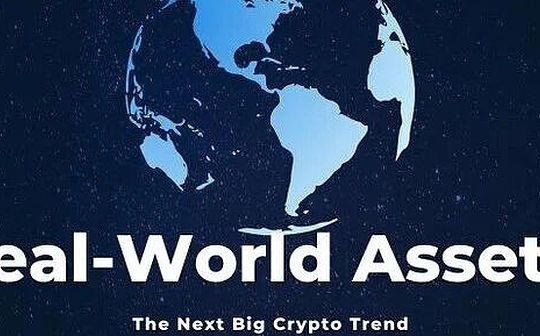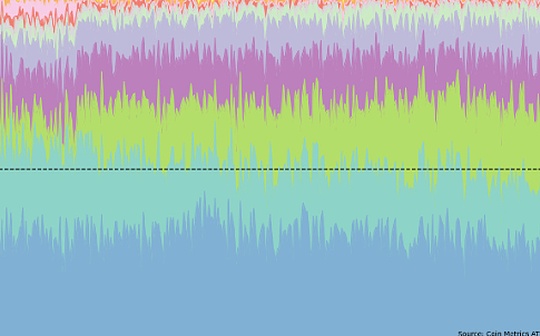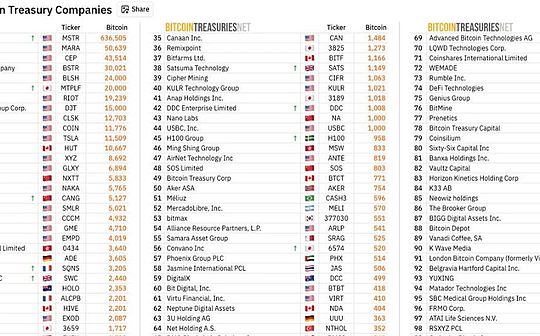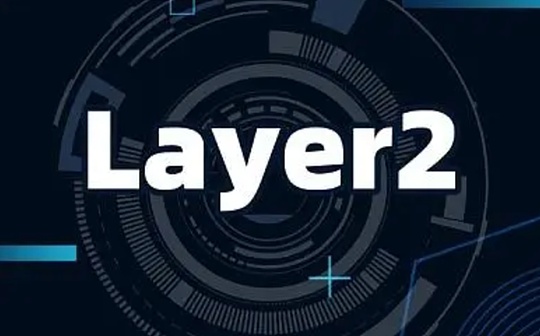
Author: sui414 Source: collective Translation: Shan Oppa, Bitchain Vision
In this article, we aim to provide a data overview of the current state of L2s.We examined the importance of the reduction in L2s gas after the Dencun upgrade in March, investigated how activities on these networks evolved, and highlighted the new challenges posed by MEV activities.In addition, we discuss potential barriers to developing MEV tools and solutions for L2s.
Advantages: Dencun adopts L2s after upgrading
Gas costs have dropped 10 times
The Gas fee for Ethereum Layer 2 (L2) consists of two parts: the cost of executing transactions on L2, and the cost of submitting bulk transactions to Ethereum L1.The specific L2 Gas fee structure and sorting rules vary for different L2s, depending on their development phase and design choices.For example, Arbitrum is first come first served (FCFS) is operated on the principle of operation, and transactions are processed in the order they are received.By contrast, Optimism (OP Mainnet) and Base, which are part of the OP Stack, adopt a priority Gas auction (PGA) model that combines L2 basic expenses and priority expenses.Users can choose to pay higher priority fees to be packaged into blocks faster and earlier.Understanding the cost structure is essential to understand ecosystem growth and MEV dynamics.
Historically, L1 fees on Ethereum account for most of the total fees incurred by users when trading on L2, accounting for more than 80% of the cost, as shown in the black bar in the above figure.However, after the March 14 Dencun upgrade, L2 transitioned from using calldata to a more cost-effective approach called “blobs” 1’ for submitting batches to L1.This temporary storage contains its own gas auction, including blob base and priority fees.
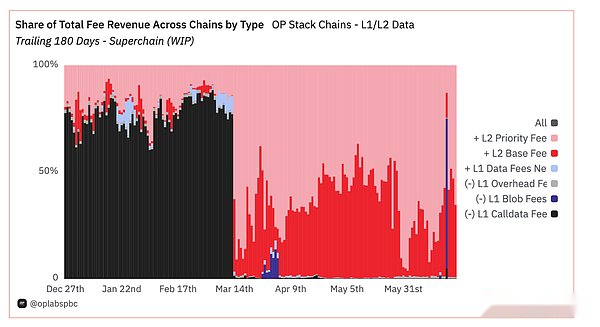
Since Dencun, L2 has paid a significant reduction in L1 fees – the chart shows a significant change in the gas cost sub-item of the OP Stack chain, with L1 costs falling from 90% to just 1%, while L2 costs now account for 99% of the total cost.This shift caused the average total gas fee for L2 to drop by about ten times overall, for example, the average gas fee for OP Mainnet plummeted from about $0.5 per transaction to $0.05.

Subsequently, L2s activity surged
After the cost reduction, the activity and usage of L2 increased significantly, as shown in the figure above, gas expenses of L2 surged.It is worth noting that on March 26, the average gas fee for Base exceeded its pre-upgrade highest level.To accommodate more transactions and reduce network congestion, Base has raised its Gas targets starting around March 26 and has made several adjustments since then.
The following figure highlights the number of daily transactions on L2, showing significant growth in networks such as Arbitrum, Base and OP Mainnet.Specifically, Base’s daily trading volume has increased fourfold, and now it processes about 2 million transactions per day.
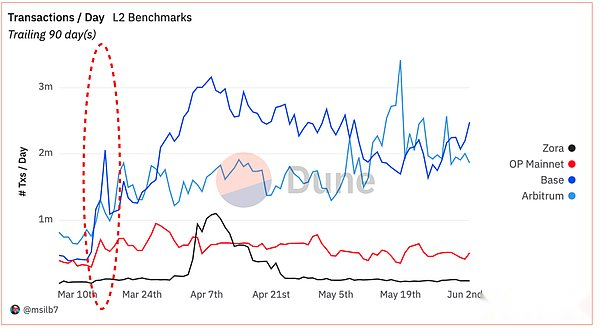
Although it is difficult to determine whether this is a result of organic participation or is affected by incentive programs and Sybil activities, the number of active addresses and DEXs for all major L2s has increased significantly as EIP-4844 upgrades, especially on Base and Arbitrum.

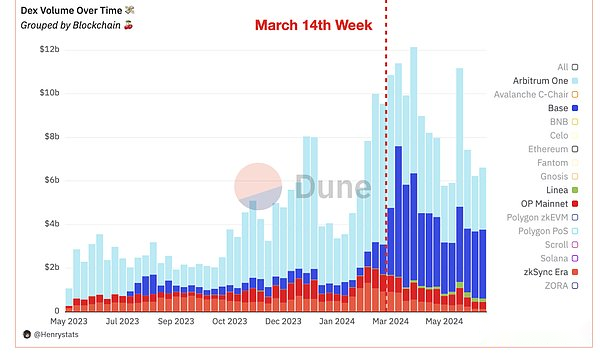
Asset transfer to L2
With market conditions improving and the memecoin season triggered by $WIF on Solana, the total lock-in value of L2 (TVL) has been rising since the end of last year.It is worth noting that Base has become the fastest growing chain, which has recently surpassed OP Mainnet’s total TVL.

Since early March, Base has had USDC inflows of about $1.5 billion, part of which Coinbase has transferred its clients and company funds to Base.According to Artemis statistics on 11 major bridges, outflows from Ethereum to major L2 have reached $14 billion since January 2024.Arbitrum leads with about $7 billion, followed by zkSync, Base and OP Mainnet.Further data from Debridge Finance, a widely used bridge between the EVM chain and Solana, confirms that Arbitrum and Base are the largest recipients of all outflows.

Bad news: Dark forests continue to expand as Gas prices drop
As we examined the transaction further, we noticed that robot trading activity was increasing gas fees and restore rates on L2.We will explore this issue more comprehensively in the next section through a case study using statistics on Base, highlighting the impact of cheaper gas after Dencun upgrades on L2.
L2s after Dencun: Similar to Ethereum before Flashbots, but no memory pool
Network congestion
The challenge has begun to emerge: On March 26, Base’s average daily Gas fee soared briefly, even surpassing the level before Dencun’s upgrade.By June 3, Base had adjusted its Gas target from 2.5M Gas/s when it upgraded to 7.5M Gas/s, which brought the average Gas cost back to around 5 cents.
The contracts that consume the most gas on Base include Telegram trading bots such as Sigma and Banana Gun, as well as wallets and DEXs such as Bitget and Uniswap.In addition, a large number of unmarked contracts involve activities such as token minting, meme currency trading and atomic arbitrage.

By the behavior of more popular Telegram Bot routers such as BananaGun, it is obvious that their transactions incur much higher gas fees than other transactions.After the upgrade, users of BananaGun Telegram bots pay a peak gas price when executing transactions on Base at 30 Gwei.Since then, the rate has stabilized at around 3 Gwei, still 43 times higher than the gas fees paid by other transactions.
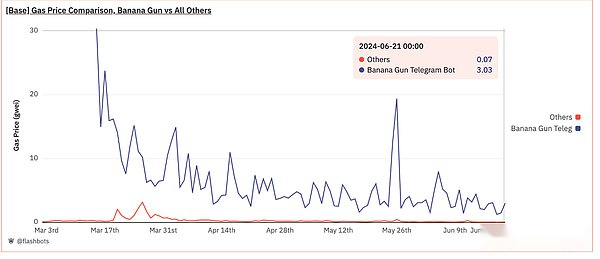
By analyzing the average monthly gas price paid by all popular DEX trading bots on Base and comparing it with all other non-Telegram-Bots transactions (black bars), it is obvious that the gas costs generated by trading bot users are significantly higher.

Return rate soars
Another important measure of blockchain is transaction rollback rates across the entire network, from which we also observe an increase in transaction rollback rates for L2 after the Dencun upgrade – especially on Base, Arbitrum and OP Mainnet.
Currently, Ethereum has a rollback rate of about 2%, while Binance Smart Chain and Polygon have a rollback rate of about 5-6%.Prior to the upgrade, Base’s rollback rate was about 2%, but has since soared to around 15%, reaching a peak of 30% on April 4.Similarly, Arbitrum and OP Mainnet have seen a cyclical surge in failed transactions, ranging from 10% to 20%.

After digging deeper, we found that the high rollback rate of L2 does not necessarily reflect the experience of every ordinary user.Instead, these rollbacks are likely to come from MEV robots.
Using the following heuristic (query), we identified a set of router contracts with similar robotic activity—which appear to experience a higher recovery rate when executing MEV withdrawal transactions:
Since the Dencun upgrade,
-
Active Router: This contract has processed more than 1,000 transactions.
-
Limited interaction EOA: Less than 10 EOA (external owned account) wallets interact as transaction senders.
-
Sender distribution: Less than 50% of transaction senders only sent one transaction, indicating that the user group does not show a long-tail distribution.This suggests that routers are unlikely to be used by retail investors.
-
Behavioral Pattern: Transaction history either covers a full 24 hours or displays multiple transactions within a single block indicating non-human behavior.
-
Swap Concentration: More than 75% of successful transactions involve swaps.
-
Detected MEV Txs: According to hildobby’s heuristic detection, more than 10% of successful transactions adopted the atomic MEV strategy 2.
Using these criteria, we detected 51 routers that may represent a conservative estimate of the lower limit of robot activity on Base.
We divide all the basic transactions processed by the router into two groups for analysis.The comparison of recovery rates between robot-like routers and other routers is shocking: the average recovery rate for robot-like contracts is 60%, six times the ~10% observed in other transactions.
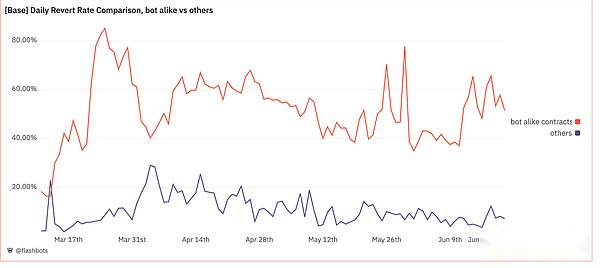
From the above data we can conclude that robot activities such as MEV robots and Telegram robots may be one of the main reasons for the high Gas fees and rollback rates in Base.
L2’s single-sequencer infrastructure, coupled with the lack of a public memory pool, contributed to the dominance of MEV policies that involved a large number of serializer spam.These strategies have severely contributed to network congestion, especially on L2s using priority Gas Auction (PGA), such as OP Mainnet and Base.The consequences are not only network congestion, but also waste block space used to undo transactions and Gas fees paid by MEV searchers.This situation reflects Ethereum’s state before Flashbots, with one obvious exception, that is, there is no MEV mezzanine on L2 due to the current lack of memory pools.
How big is the MEV on the L2?
It is crucial to gain insight into MEV activities on L2.However, so far, there is no unified L2 MEV number validated by multiple sources and robust methods.In addition, there is a lack of real-time monitoring data similar to the work done for Ethereum (e.g. mev-inspect, libmev, eigenphi 3) to obtain L2 MEV volume and searcher profits.
Some of the L2 MEV datasets and studies published to date include:
-
Open Source Dataset 2 built by hildobby on Dune Analytics (Heuristic Link: Mezzanine 1 | Sandwich | Atomic Arb 3)
-
Research paper funded by Flashbots, Quantification of MEVs on Layer 2 Networks 1, written by Arthur Bagourd and Luca Georges Francois, quantified MEVs on Polygon, OP Mainnet and Arbitrum using mev-inspect.
-
Research paper Scrolling in the Shadow: Analyzing MEV Extraction in Layer 2 Summary 3 Quantifying activities by Christof Ferreira Torres, Albin Mamuti, Ben Weintraub, Cristina Nita-Rotaru, and Shweta Shinde and discussing the use of the sorter role and its L2 batchesNew L2 MEV strategy for confirming delays
In addition to the above resources, Sorella Labs 2 is about to release their MEV data indexer tool Brontes, which will be an open source repository for both the Ethereum mainnet and L2.The Flashbots and Uniswap Foundation are seeking funding to expand L2 MEV classification and quantification.If you have already worked in this field or are interested in collaborating, please contact the Flashbots Market Research Team (@tesa on Telegram:

@tesa_fb)!
Although further verification is needed, hildobby’s dataset on Dune Analytics is a valuable preliminary benchmark:


Over the past year, the six major L2s (Arbitrum, OP Mainnet, Base, Zora, Scroll and zkSync) have traded over US$3.6 billion in atomic arbitrage MEV transactions, accounting for 1% to 6% of all DEX transactions on each chain.%.These MEV volumes are mainly concentrated in Arbitrum and OP Mainnet, but have recently turned to Base and zkSync.
Compared with the atomic arbitrage volume, the sandwich trading volume on L2 is significantly lower, in sharp contrast to the situation on Ethereum, which is four times the arbitrage volume.This difference is due to the single sequencer setup of L2, which essentially does not introduce memory pools, in which case the searcher will not be able to execute the sandwich MEV, observing the user’s transactions from the memory pool (unless there is a memory pool leak or from the singleSerializer’s sandwich).On the contrary, strategies such as atomic arbitrage, blind rollback, statistical arbitrage and liquidation are the most viable choices for searchers on L2.

MEV Market Size
How much MEV revenue is left in L2?
While it is difficult to accurately quantify the MEV market, we can examine the numbers of other ecosystems that employ MEV solutions for a scale comparison:
-
On Ethereum L1, the MEV-boost block generates approximately US$968 million in annual revenue for validators (estimated at the ETH price of US$3,500); the median value of the MEV-boost block is 4 of the vanilla validator block valueTime.

-
On Solana, the additional MEV revenue collected by validators from validator tips through Jito’s bundled service is approximately $338 million (estimated at SOL price of $130).

While the specific figures of Base’s MEV trading volume are not clear, the market size can be estimated by analyzing the revenue of Banana Gun Telegram Bot, one of the most active bots in the field.The bot trades as L2 on Base as comparable to its trading volume on Solana – continually generating more than $1 million in daily trading volume, so the daily fee per chain is over $10,000.

Please note that there may be significant differences in market share of Banana Gun Bot on Solana and Base.For example, Solana has several other major Telegram robots, such as Sol Trading Bot and BonkBot, while Base-enabled fewer Telegram robots are likely to be available.As a result, Banana Gun’s sales volume cannot be converted into Base’s total MEV revenue at its Solana revenue ratio.
But, consider another prediction using different metrics: In March alone, Banana Gun Telegram Bot paid over $23 million to Ethereum builders and validators!When comparing cross-chain transaction volume, its transaction volume on Base actually exceeded Ethereum in the week from March 26 to April 1 (as in the picture above), indicating a huge revenue potential for MEV on Base.
Of course, Base and Ethereum’s MEV ecosystem are very different.The competition for MEVs on Base may be much smaller than that on Ethereum, which means that bots need to bid less to validators.However, the meme currency trading robots operate primarily through blind sniping and arbitrage, which is still feasible in Base’s serializer settings.
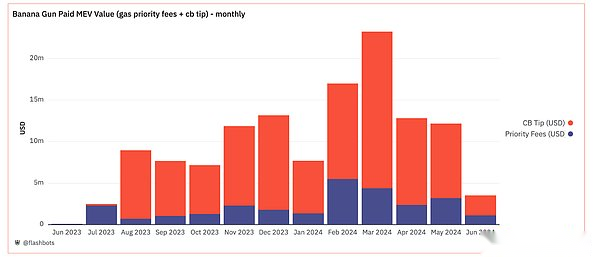
Call for MEV to pay attention
Ethereum has built a complex MEV ecosystem with infrastructure tools serving participants at different levels in the supply chain.At the protocol level, MEV-boost allows validators to outsource the block building process through auctions.For searchers, the bundled services provided by block builders of Ethereum (similar to Jito Labs on Solana and FastLanes on Polygon) enable searchers to propose MEV policies with recovery protection.These services ensure that builders simulate transactions and process only those that are not recoverable.Additionally, private RPC services like Flashbots Protect provide retail investors with a way to avoid the risk of public memory pools and related risks being sandwiched in the middle.The current form of L2 still has considerable room for progress in developing similar MEV infrastructure.
Why should we consider L2’s MEV solution?
Even without a memory pool, the MEV still exists.MEV strategies such as statistical arbitrage (CEX-DEX arbitrage), atomic arbitrage (DEX-DEX arbitrage), and clearing maintain market efficiency by clearing outstagnant liquidity in AMM and lending markets.
However, there is no mature MEV infrastructure like bundled services, negative external effects can occur.Without a memory pool, most MEV policies will default to spam policies, resulting in:
-
Response rates across the entire network increase;
-
Gas fees have increased, causing network congestion.
By introducing bundled services and shifting MEV competition pressure from the chain to Sidecar, users can be exempted from the high gas fees of MEV robots.Searchers can also make higher profits from recovery protection, as the cost of failure can be reduced.
For L2 designed to have a shared sorter, most solutions today require users to submit their transactions to a public memory pool, reintroducing the phenomenon of “mezzanine”.At this time, MEV protection solutions (such as sending user transactions directly to private RPCs of block builders such as Flashbots Protect) can provide protection against the “mezzo” phenomenon, and even provide MEV or priority fee refunds to provide users with more informationGood execution and better price.
However, there are still some challenges in more complex MEV infrastructure.First, as the value obtained by the sequencing staff increases, the economy of search changes, causing the searcher’s marginal profit to decrease over time.This, in turn, raises the question of how sustainable the competitive search strategy is in the long run.We expect market forces to play here, with common search strategies paying most but not all of the value to the sequencing staff, while less common search strategies paying less value.
In addition, the order flow dynamics of existing MEV infrastructures, such as Ethereum’s block building market, are still developing rapidly.At the time of writing, they are important contributors to the centralization of the blockchain market and the rise of private memory pools on Ethereum L1.How to ensure competitive and fair block building markets remains an open challenge.
Finally, due to the unique properties of L2 such as faster block time, cheaper block space and relatively more centralized governance, its MEV solution may also be different from the MEV solution on Ethereum.It is not clear whether the fast blocking time (such as Arbitrum’s 250ms block) is compatible with the current performance and requirements of existing MEV infrastructure.Additionally, the rich and cheap block space provided by L2 has dramatically changed the dynamics of searches, making spam a more prominent issue and new solutions may be needed.Finally, L2 is relatively more concentrated than other settings such as Ethereum L1.In this case, additional requirements may be allowed for MEV service providers – such as requiring block builders not to incorporate users – to achieve fair market results.



